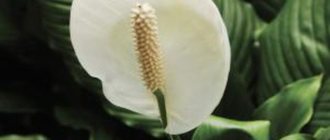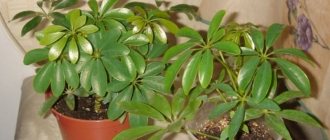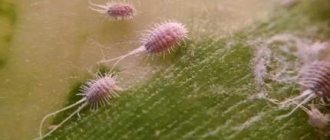Unfavorable changes that are associated with the development of spathiphyllum and its appearance are often associated with its growing conditions. The appearance of a tropical flower is an indicator of its condition, which serves as a kind of “signal” in case of improper care. The question of why spathiphyllum leaves turn black (sometimes the tips dry out) is quite relevant, since there are several reasons for the appearance of this type of disease. If you identify the signs in time and take action by creating the most comfortable growing conditions, the flower can even be saved from death.
Causes of blackening of leaves
Initially, in order to prevent unfavorable situations, you need to know the features of spathiphyllum. For example, its tropical origin means that at home it needs optimal humidity. A representative of the flora, resembling calla lily inflorescences, will feel good at home, where air humidity is maintained within 60-70%.
This is due to the fact that the roots of tropical plants are quite delicate and tend to rot when exposed to excess moisture. Therefore, like most exotic representatives of the flora, it needs a special approach to maintain its attractive appearance.
The leaves of spathiphyllum grown at home turn black for many reasons.
Dry air
“Women’s Happiness” does not tolerate dry air in the room, like many indoor flowers. This is reflected in the appearance of the pet - the tips of its leaves dry out and then darken. A tropical flower will feel more comfortable, as previously mentioned, in a more humid environment. Therefore, try to spray it regularly with a spray bottle. In cool rooms, it is better not to overdo it, as the plant’s condition will noticeably worsen due to the death of the roots.
After transplantation, the spaciphyllum gets sick and the leaves also turn black, because it spends all its energy on restoration.
Top dressing
Spathiphyllum leaves also turn black because it lacks nutrients and fertilizing. The solution to this problem directly depends on the quantity and quality of fertilizing. The tips of its leaves dry out or begin to turn black if the plant is fertilized extremely rarely. As a rule, in the spring-summer period it is necessary to fertilize a tropical flower approximately once every 7-10 days. In autumn and winter, fertilizing is carried out less frequently in order to transfer the plant to the resting phase. To do this, it is enough to fertilize the flower once a month.
As a rule, this can be expressed as an excess of minerals. To heal the plant, it is worth removing damaged leaves and temporarily stopping fertilizers. In this way, you will help the flower recover and understand what to do next to keep it “in shape.”
Diseases . A young flower is susceptible to some diseases, so you can lightly treat the plant with special substances that protect against infections and pests.
Watering
Spathiphyllum foliage may darken if it is not watered correctly or excessively. To prevent stagnation of moisture in the soil, water the plant as the top layer of soil dries out. At the same time, do not forget to remove excess water from the collection container within 2 hours after watering.
What kind of water you use for irrigation is also an important factor. If you use soft water for watering, preheated to room temperature, then your green pet’s foliage will not dry out and darken.
An urgent transplant with a complete replacement of the earthen coma is required:
- Prepare a new pot of the same volume as the old one. Disinfect the new container with Furacilin solution - dissolve 1 tablet in 50 ml of boiling water.
- Remove the plant from the old container, free the roots from the soil, rinsing them under running water.
- Remove rotten areas with a sharp scalpel disinfected in alcohol.
- Immerse the roots for 10 minutes in a solution of “Fundazol” (5 g of substance per 250 ml of water). hold the plant on a paper towel for an hour to dry the roots.
Dust the roots with charcoal. Place expanded clay drainage at the bottom of the pot, and then a layer of new soil, the humidity of which varies between 40–50%. Place the plant in the pot, aligned with the root collar, and sprinkle soil into the voids.
Where to put it - lighting
Spathiphyllum, whose leaves turn black, may also suffer from improper placement. Direct sunlight, as well as lack of light, have an adverse effect on the plant. Therefore, it is important, when purchasing such a flower, to choose the optimal place for it. It is advisable to place it on the windowsill of a south, east or west window. If you plan to grow “Women’s Happiness” in the back of the room, take care of additional lighting.
To prevent damage to the foliage of a houseplant, bathe it once a week in the warm season. Such procedures will help maintain a healthy and decorative appearance. Usually, after “water procedures”, the foliage of spathiphyllum shines for a long time.
Sometimes blackening and dropping leaves can indicate rejuvenation of the flower, since in this way it saves its energy for the development of new, young shoots.
In some cases, the leaves of spathiphyllum not only dry out at the edges, but also characteristic drying black spots appear in the central part of the leaf blades. As a rule, dark brown or black spots on spathiphyllum may indicate excessive watering, which accompanies the indoor plant for quite a long time. In this case, the root system of the ornamental crop quickly begins to rot, which causes blackening of the leaves.
What to do if the tips of spathiphyllum leaves turn black due to large doses of fertilizer?
Indoor plants require almost four times less fertilizer than those grown in greenhouses, especially using hydroponic systems.
Before sale, greenhouse plants are planted in transport pots, adding a special complex of long-acting fertilizers under the roots. Such substances, with regular watering, can ensure the preservation of the bush for up to 4–6 weeks.
And then the owner of the flower needs to fertilize it himself. And here you cannot overdo it, otherwise an excessive amount of fertilizer will become the reason why the leaves of the spathiphyllum turn black, which just yesterday delighted with a healthy gloss and rich color. In addition, spathiphyllum reacts by slowing growth and necrosis not only on the leaf blades, but also on parts of the root system. Moreover, mature leaves respond more sharply to excess nutrition.
Since the problem concerns both the green part of the plant and its underground organs, all affected areas need to be inspected and removed, and, if possible, the concentration of fertilizers in the soil should be reduced. After transplantation, the spathiphyllum is treated with an epin solution, and then the usual feeding schedule for the plant is established.
From early spring to early autumn, spathiphyllum is fertilized twice a month, alternating mineral and organic additives, and microelements are applied foliar. In winter, when the plant is in relative rest, the bush should not be fertilized, and watering should be reduced so as not to cause rotting of the roots and blackening of the tips of spathiphyllum leaves.
Only with proper care and attentive attention, even such an unassuming flower as spathiphyllum will regularly delight with flowering and not cause trouble to the owner.
Flowers turn black
Spathiphyllum flowers are very attractive, and abundant flowering makes this indoor plant very decorative. Spathiphyllum has a very high level of sensitivity to waterlogging of the soil, and if this happens, the cores turn black and the flowers darken.
Insufficient soil moisture when growing “female happiness” (as spathiphyllum is often called) is also very difficult for the plant to tolerate and negatively affects the appearance of the flowers. The plant needs almost constant and regular spraying of the leaves, but moisture should not be allowed to get inside the flowers themselves.
How to care for a plant at home to save it?
If a florist notices the blackening of the leaves of the “female happiness” flower and determines the reasons, then to effectively treat the blackening plant, he needs to perform the following steps :
- Treat the crop with a fungicide. Instructions for dilution and use are on each package.
- Raise the air temperature to +26 degrees.
- Remove the plant from the pot and inspect the roots for fungal damage. If there are rotten parts, cut them off and treat the cut areas with crushed coal.
- Reduce the frequency and abundance of watering by half. The next moistening of the soil should occur after a third of the soil layer has dried.
- Use complex fertilizers. In spring, fertilizing is applied every week. In summer, you can apply once every 10 days. During the rest period, it is allowed to feed the crop for its complete restoration - once a month will be enough.
- Trim off all affected areas of spathiphyllum.
- Spray the plant with water (you can add a growth stimulator to it).
The leaves are turning yellow
Initially, it is important to understand why the leaves of indoor spathiphyllum turn yellow. After all, this may not be a manifestation of the disease. There may be two reasons for this:
- Some representatives of such plants, in preparation for flowering or reproduction, can use all their powers in this way;
- The flower requires attention after it has bloomed, “signaling” that it needs additional strength to restore itself.
Such representatives of the flora at a young age are less susceptible to diseases. An adult spathiphyllum, whose leaves turn black and yellow, succumbs more quickly to unfavorable conditions due to aging. Therefore, it is always important to pay attention to which leaves begin to deteriorate first.
If you notice that old shoots are dying at the base, this may mean that the plant is thus getting rid of parts that are considered unviable. The indoor flower is trying to save energy and nutrients for its rejuvenation, for the growth of young shoots. If fresh young leaves turn yellow, this indicates exposure to external factors. In particular, direct sunlight.
Plant prevention
If you have managed to identify and eliminate the cause of the blackening of the leaves, you should take certain measures to prevent similar problems in the future.
Preventive measures for spathiphyllum are as follows:
- Watering should be plentiful, but not excessive. You can determine that a plant needs moisture by the degree of moisture in the substrate. If it has dried to a depth of 2-3 cm, you need to water the flower.
- To increase air humidity, especially in the cold season, you should regularly spray the plant or wash its leaves with a damp sponge. This event will not only increase the air humidity in the room, but will also serve as excellent protection against pests.
- Fertilizing must be done carefully, strictly observing the dosage. In the case of spathiphyllum, it is better to under-fertilize a little than to cause an excess of minerals in the soil.
In addition, you need to carefully select a place to place spathiphyllum in the house. It is advisable to place it on eastern or western windowsills, where the light is bright enough, but diffused, and the plant cannot suffer from sunburn.
Natural causes of greening of spathiphyllum flowers
If a crop (spathiphyllum) has a green flower, not every gardener knows why this happens. There are many natural reasons that lead to such problems. The older the plant, the less likely it is to pollinate. In such a situation, the blanket becomes green and blends in with the leaves. This is due to the lack of need to attract insects.
Note! If you don’t want to see green flowers on the plant, you can carefully trim them. This procedure is also carried out to rejuvenate the culture. Thanks to timely pruning, it will be possible to stimulate the appearance of new inflorescences.
Changes in flower color may be due to natural factors
Why do leaves and flowers turn black, what should I do?
If blackness appears not only on the deciduous mass, but also affects the delicate flags, your pet’s health is at risk! This reaction of the flagolist is typical when the substrate is excessively moistened, leading to rotting of the roots.
Know! If only the cobs and spathes begin to turn black, the inflorescence got wet during spraying or watering. Avoid sprinkling during flowering and do not allow droplets of liquid to fall on the buds.
What to do to save spathiphyllum? When the roots rot, there is only one option - an emergency transplant. It is performed as follows:
- Remove the diseased individual from the pot.
- Place the root system in a bucket of water, carefully free the roots from the earthen ball.
- Carry out a thorough inspection, remove with a sterile knife all rotten parts (yellow or brown, soft to the touch) to healthy tissue.
- Soak the root lobe in a fungicide solution or a light pink solution of potassium permanganate.
- Treat the wounds with crushed charcoal and dry the roots for 2 hours.
- Line the bottom of the new pot with drainage and add some fresh soil. Place the spathiphyllum in the prepared container and fill the gaps.
- The finished soil mixture contains a small amount of moisture, so additional watering is not required. If the soil is dry, water it a little.
- When the time for the next irrigation comes, water the flower with warm, settled water with the addition of Kornevin. Spray the transplanted specimen daily.
Attention! Do not use an old pot for replanting; fungal spores may remain in it. As a last resort, pour boiling water over it and completely immerse it in a raspberry solution of potassium permanganate for 30-40 minutes.
Comments (4)
Amina
05/08/2018 at 01:59 pm |
This year I also encountered this problem, but the flower was still saved. I just changed the soil, dried the roots a little and placed it on the south window. Now it pleases me with abundant flowering.Answer
Yulia Expert Plodogorod
12/09/2019 at 00:33 |
Hello Amina! If this happens as a result of overwatering, it is important not only to dry the roots, but also to sanitize them. All rotten and softened roots should be removed during the transplantation process.
When the problem is noticed in time, the root system of the plant is not significantly affected and root removal is not required. But, still, for prevention, we recommend that after replanting, carry out several moistenings with the addition of fungicides.
In addition to replacing the soil with clean soil, we also recommend taking care of its looseness and drainage. In addition, the substrate must be sufficiently nutritious. Then the plant will have high immunity, which will increase its resistance to destructive factors.
In case of such difficulties, it is important to replace not only the substrate, but also the container where the flower was located. Or, the pot should be thoroughly disinfected, for example, doused with boiling water, and then cleaned with baking soda.
If the crop is located on a south window, this will provide it with good lighting. But, burns are possible in the summer, which is why the foliage will begin to turn yellow. Brown spots may also appear.
To avoid the problems described, we recommend shading the flower during the midday hours at the end of spring and all summer, when the sun is brightest. You can simply fix a small piece of parchment on the glass or place the plant a little further from the window. Then the lighting will be softened a little by tulle.
When flowers are placed on southern windows, not only burns are possible, but also dehydration. We recommend making sure that the leaves do not lose turgor. If this starts to happen and shading does not help, you should choose a different place for the culture.
Answer
Katerina
08/13/2018 at 18:31 |
“Women's Happiness” is a flower that is very responsive to care and care, but in itself is not very demanding. From one bush given by my husband, I already have 8 of them. Timely replanting and watering guarantee rapid flower growth. Dry ends immediately reveal the plant's resentment. The only thing I can’t understand is why in 2 years only 2 bushes bloomed.
Answer
Yulia Expert Plodogorod
09.12.2019 at 01:11 |
Hello, Katerina! With proper care, healthy plants produce buds two or even three times during the year. There are several reasons why the plant Women's Happiness does not bloom. If some plants in your collection are blooming, the reason is most likely not due to lighting or temperature conditions.
Quite often, the described culture does not produce buds, as it spends energy on conquering the territory in the pot. Until the roots fill all possible space, buds can not be expected.
Therefore, we do not recommend planting spathiphyllum in a container that is too large. Moreover, this is fraught with rotting of the plant’s root system. The roots cannot reach all the water received during moistening and it begins to stagnate.
If such a large pot was used, we recommend replanting. It is better to choose a container whose diameter is only 1.5-2 cm larger than the size of the root system.
Another possible reason for the lack of flowers is depleted or initially unsuitable soil. This is usually accompanied by a general loss of decorativeness. The foliage becomes pale and smaller.
But it is important to note that the opposite also happens. If the crop has a lot of beautiful and rich green foliage, but no buds, it may be overfed with fertilizers. This happens if the applied products are not balanced and include mainly nitrogen. It is important that the fertilizer also includes potassium, phosphorus, boron and other substances.
To correct the situation, we recommend normalizing the feeding regime. Foliar feedings that contain the described substances have a good effect. From the roots you can choose any complex for flowering house plants.
The main thing is not to overuse stimulants, otherwise the culture will be depleted and may begin to hurt.
Although this crop tolerates shade well, it is important to strike a balance. The best place would be a window with diffused lighting.
Sometimes the buds of the described culture acquire a greenish tint. This is a natural process and a feature of this plant; it does not require adjustment. Usually this process indicates that the bud has begun to fade.
Answer
Reasons for the appearance of green inflorescences before and during the flowering of female happiness
Why does the spathiphyllum flower turn green? The culprit may be improper application of fertilizers. This symptom often indicates an excess or deficiency of beneficial elements.
The plant may also bloom green due to lack of lighting in the room. If white flowers appear on a crop, but then they change color, it is important to provide it with more light.
Important! In some cases, the appearance of green flowers is due to excess light. Direct sunlight on the bush also leads to this problem.
If the change in foliage shade is due to excess sun, the plant must be moved to a room with soft and diffused light. It is important to ensure that the bush is not in a too dark place.
Greening and dying of the blanket can occur with a sudden change in temperature. Most often this happens when the temperature drops to 15 °C. The cause of problems is violation of watering rules. If the soil is over-moistened, the plant may bloom green.
The green color of the bedspread occurs when the temperature regime is violated
Quite often, the provoking factors are various diseases. Infection of a culture can be suspected by the following signs:
- the plant does not bloom;
- leaves dry out or become stained;
- the plant stops growing and developing;
- flowers and leaves become small.
Why do spathiphyllum have green flowers? The following pathologies lead to this problem:
- root rot. When infected, green flowers appear on the bushes. The roots become covered with red spots, and the leaves become brown. If all fragments of the plant are affected, it dies. To save the flower, it needs to be transplanted into new soil and sprinkled with phytosporin. You can also use a solution of potassium permanganate. The affected fragments must be removed and the sections sprinkled with charcoal. The plant is moved to disinfected soil. To prevent the disease, it is necessary to normalize temperature parameters and watering regime;
- late blight This pathology develops in conditions of high humidity and constant overflow. Fungal spores provoke damage to the root collar. It acquires a soft consistency and begins to decompose. Late blight is considered one of the most dangerous pathologies, which is very difficult to cope with. To avoid infecting other crops, you need to destroy the flower itself and the soil in which it grew;
- chlorosis. This disease provokes a change in the color of the bedspread. The pathology is caused by violation of the rules of care and improper application of fertilizers. Chlorosis affects the roots, in particular during transplantation. The first symptoms of the disease include green flowers and the appearance of formations on the leaves. The spots spread quite quickly. To save the crop, you need to stop applying fertilizers and adjust the watering regime;
- gommosis. With this pathology, the stems, stipules and flowers become small in size. At the same time, the leaves wither and dry out. If the disease is protracted, the plant cannot receive nutrition. This leads to leaf fall and death of the crop. The infection usually comes from running water or from other plants. The greatest danger to spathiphyllum are callas, anthuriums, and dieffenbachia;
- sooty fungus. Infection occurs due to damage to the flower by parasites. When attacked by aphids or scale insects, the spathiphyllum becomes covered with a slimy substance. It provides a favorable environment for the proliferation of spores. Pathology provokes a change in the shade of the bedspread and the formation of a black coating. This leads to disruption of the photosynthesis process and the development of diseases. To save the plant, you need to use a soap solution and insecticidal preparations.
Changes in flower color are often associated with disease











